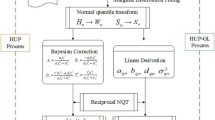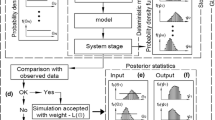Abstract
Uncertainty assessments of hydrological prediction results can reflect additional hydrological information and reveal important hydrological characteristics of river basins, which is of great significance to disaster prevention and reduction. The hydrological uncertainty processor (HUP), which is a key part of the Bayesian forecasting system (BFS), has derived a variety of methods for hydrological uncertainty forecasting. The HUP allows for any form of marginal distributions of hydrological data and does not require a unified estimation structure for the marginal distribution function. The Gaussian mixture model (GMM) is a probability distribution estimation model that can approximate any probability distribution with arbitrary precision. In this paper, the GMM was used to estimate the marginal distribution of observed and modelled data, and this method is called HUP-GMM. The uncertainty of river discharge at the Yichang hydrological station on the main stem of the Yangtze River in China is predicted by the HUP-GMM. The Weibull and Gamma distributions, which are commonly used hydrological probability distributions, are compared to analyse the performance of the GMM. In June, when the measured flow h3 is 13,850 m3/s and the GMM, Gamma and Weibull distributions are used, the prior probabilities are 1.63E-04, 1.05E-04 and 9.50E-05 and the posterior probabilities are 2.57E-04, 1.61E-04 and 1.38E-04, respectively. In September, when the measured flow h3 is 35,400 m3/s and the GMM, Gamma and Weibull distributions are used, the prior probabilities are 5.98E-05, 2.21E-05 and 2.18E-05 and the posterior probabilities are 1.64E-04, 9.15E-05 and 8.43E-05, respectively. The results show that the performance of the uncertainty estimation of the prior and posterior probability distributions in the HUP-GMM has been improved.









Similar content being viewed by others
References
Allen FR, Ambikairajah E, Lovell NH, Celler BG (2006) Classification of a known sequence of motions and postures from accelerometry data using adapted Gaussian mixture models. Physiol Meas 27:935–951
Beuzen T, Splinter KD, Marshall LA, Turner IL, Harley MD, Palmsten ML (2018) Bayesian networks in coastal engineering: distinguishing descriptive and predictive applications. Coast Eng 135:16–30
Biondi D, De Luca D (2013) Performance assessment of a Bayesian forecasting system (BFS) for real-time flood forecasting. J Hydrol 479:51–63
Borsuk ME, Reichert P, Peter A, Schager E, Burkhardt-Holm P (2006) Assessing the decline of brown trout ( Salmo trutta ) in Swiss rivers using a Bayesian probability network. Ecol Model 192:224–244
Bretthorst GL, Hutton WC, Garbow JR, Ackerman JJH (2005) Exponential model selection (in NMR) using Bayesian probability theory. Concepts Magnet Reson Part A 27A:64–72
Chen L, Singh V, Huang K (2018) Bayesian technique for the selection of probability distributions for frequency analyses of Hydrometeorological extremes. Entropy 20:117
Gong ZW (2008) Least-square method to priority of the fuzzy preference relations with incomplete information. Int J Approx Reason 47:258–264
Hao CF, Jia YW, Wang H (2012) Atmospheric and hydrological models' coupling and application in flood forecasting of the Weihe Basin. J Hydraul Eng 43:1042–1049
Kelly KS, Krzysztofowicz R (1997) A bivariate meta-Gaussian density for use in hydrology. Stochastic Hydrol Hydraul 11:17–31
Kim SC, Kang TJ (2007) Texture classification and segmentation using wavelet packet frame and Gaussian mixture model. Pattern Recogn 40:1207–1221
Krzysztofowicz R (1999) Bayesian theory of probabilistic forecasting via deterministic hydrologic model. Water Resour Res 35:2739–2750
Krzysztofowicz R, Herr HD (2000) Hydrologic uncertainty processor for probabilistic river stage forecasting: precipitation-dependent model. J Hydrol 36:2643–2653
Krzysztofowicz R, Kelly KS (2000) Hydrologic uncertainty processor for probabilistic river stage forecasting. Water Resour Res 36:3265–3277
Kutoyants YA, Yoshida N (2007) Moment estimation for ergodic diffusion processes. Bernoulli 13:933–951
Li W, Zhou J, Sun H, Feng K, Zhang H, Tayyab M (2017) Impact of distribution type in Bayes probability flood forecasting. Water Resour Manag 31:1–17
Liu Z, Guo S, Xiong L, Xu CY (2018) Hydrologic uncertainty processor based on copula function. J Hydraul Eng 49:332–342
Luque-Fernandez MA, Schomaker M, Rachet B, Schnitzer ME (2018) Targeted maximum likelihood estimation for a binary treatment: a tutorial. Stat Med 37:2530–2546
Mohammadi-Ghazi R, Marzouk YM, Büyüköztürk O (2018) Conditional classifiers and boosted conditional Gaussian mixture model for novelty detection pattern recognition:S0031320318301122
Neil JJ, Bretthorst GL (1993) On the use of Bayesian probability theory for analysis of exponential decay data: an example taken from intravoxel incoherent motion experiments. Magn Reson Med 29:642
Permuter H, Francos J, Jermyn I (2006) A study of Gaussian mixture models of color and texture features for image classification and segmentation. Pattern Recogn 39:695–706
Rasmussen CE (2000) The infinite Gaussian mixture model. Advances in neural information processing systems: 554–560
Ren-Jun Z (1992) The Xinanjiang model applied in China. J Hydrol 135:371–381
Reynolds DA, Quatieri TF, Dunn RB (2000) Speaker verification using adapted Gaussian mixture models. Digit Signal Process 10:19–41
Richardson S, Green PJ (1997) On Bayesian analysis of mixtures with an unknown number of components (with discussion). J Royal Stat Soc: Ser B (Stat Methodol) 59:731–792
Vrugt JA, Braak CJFT, Clark MP, Hyman JM, Robinson BA (2008) Treatment of input uncertainty in hydrologic modeling: doing hydrology backward with Markov chain Monte Carlo simulation. Water Resour Res 44:5121–5127
Wilson R (2000) Multiresolution gaussian mixture models: theory and applications. IEEE international conference on pattern recognition, Citeseer,
Yin H, Changan LI (2001) Human impact on floods and flood disasters on the Yangtze River. Geomorphology 41:105–109
Zhang X, Liu P, Cheng L, Liu Z, Zhao Y (2018) A back-fitting algorithm to improve real-time flood forecasting. J Hydrol
Acknowledgements
This work is support by the National Key R&D Program of China (2016YFC0402210), the National Natural Science Foundation Key Project of China (No. 91547208, No. U1865202) and the National Natural Science Foundation of China (No. 51579107).
Author information
Authors and Affiliations
Corresponding author
Ethics declarations
Conflict of Interest
None.
Additional information
Publisher’s Note
Springer Nature remains neutral with regard to jurisdictional claims in published maps and institutional affiliations.
Appendix
Appendix
1.1 Expectation Maximum
Input: observation data y1, y2, ⋯, yN, Gaussian mixture model;
Output: parameters of the Gaussian mixture model.
-
(1)
take the initial value of the parameter and start the iteration
-
(2)
E step: according to the current model parameters, the response of model k to observed data was calculated
-
(3)
M step: calculate the model parameters of the next iteration
(4) repeat step (2) and (3) until they converge.
Rights and permissions
About this article
Cite this article
Feng, K., Zhou, J., Liu, Y. et al. Hydrological Uncertainty Processor (HUP) with Estimation of the Marginal Distribution by a Gaussian Mixture Model. Water Resour Manage 33, 2975–2990 (2019). https://doi.org/10.1007/s11269-019-02260-5
Received:
Accepted:
Published:
Issue Date:
DOI: https://doi.org/10.1007/s11269-019-02260-5




